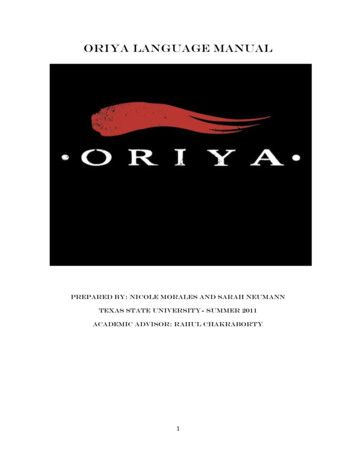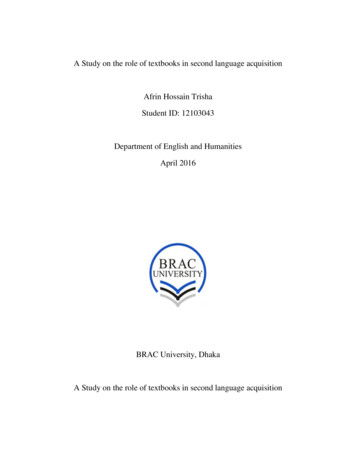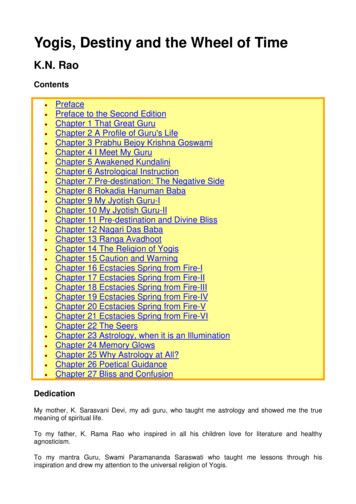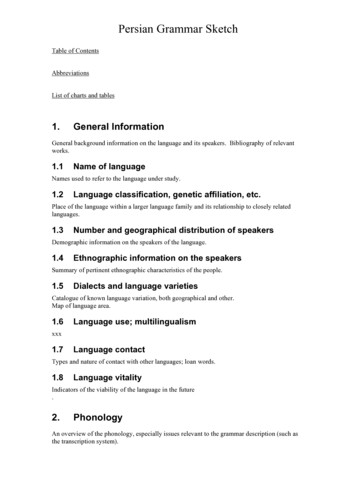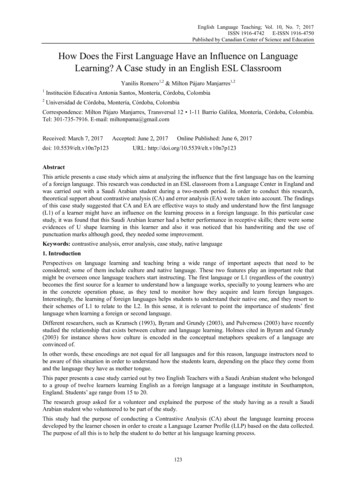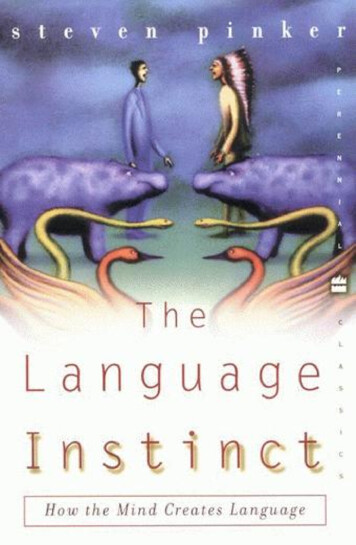
Transcription
1Gujarati LanguageManualJya jya vase gujarati, tya tya vase Gujarat(Meaning: Wherever in the world Gujaratis live, there exists a Gujarat)
2Written by:Jessica Cantero, B.S.Caitlind Davis, B.A.Brittany Hammer B.S.TEXAS STATE UNIVERSITY2010
3Table of ContentsDemographic Information . .5U.S. population .5World population . 5Geographic Distribution .6Demographic Facts . .6History and Religion . 7History of Gujarat .7Ethnicity and Religion 10Culture.11Food .11Dress .12Music 13Traditions . 13Economy . 14Linguistic Community .15History of Gujarati .15Dialects in India .17Helpful Reminders . 18Language Components .19Phonology 19Morphology .21
4Syntax .21Pragmatics . 22Common Errors in Gujarati . 23Test and Assessment Materials .23Global Institutions .23Specialized Speech Language Pathologists . 24Web resources . 25Research Articles . 26References .27
5Demographic InformationU.S and World Wide PopulationThe Gujarati people live in the northwestern part of the Indian subcontinent, in the stateof Gujarat. According to the 2001 census data, the population of the Gujarat State was50,671,017. Many Gujaratis inhabit the states of Rajasthan, Maharashtra and MadhyaPradesh of India and the Indian capital of New Delhi as well as the former Portugueseruled territories of Daman and Diu and Dadra and Nagar Haveli. Gujarat is a veryindustrialized state of India.Above image from: http://www.sindhtoday.net/imgs/3/Gujarat 13561391.jpg
6Geographic DistributionGujarati is the official and primary language of Gujarat. Other languages spoken includeEnglish, Hindu and other Indic languages. There are approximately 46 million speakersof Gujarati worldwide, making it the 23rd most spoken language in the world. About 45.5million reside in India, 150,000 in Uganda, 250,000 in Tanzania, 50,000 in Kenya androughly 100,000 in Pakistan. Gujarati speakers also exist in North America and theUnited Kingdom as well.According to the U.S Census in 2006, there were 1,417,000 people in the U.S. whospoke Gujarati, Hindu or other Indic languages. Gujaratis comprised 299,000 of thesenumbers, suggesting approximately 20% of Indian Americans are Gujarati. Early 2010figures estimate that there are 104,000 people who speak Gujarati in Canada. Themajority of those live in the Greater Toronto area, making Toronto the city with the mostGujarati people in North America.Demographic Facts On May 1, 1960, Gujarat was created out of 17 northern districts of the formerstate of BombayLocated on the western coast of India, has the longest coastline of 1,600 KmBounded by the Arabian Sea to the west and south west and by Pakistan in theNorthPopulation of approximately 50.7 million (five per cent of India) and an area of1,96,024 Sq. Km. (six per cent of India)It has States of Rajasthan and Madhya Pradesh towards the north east and east,Maharashtra and the Union Territories of Daman, Diu and Nagar Haveli, towardsthe southGandhinagar, the capital city of Gujarat is located close to Amdavad(Ahmedabad), the commercial capitalDiverse climatic conditions with mild and pleasant winters and hot and drysummers and heavy monsoonThe state currently has 26 districts (231 talukas, 18,618 villages,242 townsTaken from: hy.htm
7History and ReligionHistory of GujaratGujarat is a State in northwestern India, on the border with Pakistan and Rajasthan inthe north east, Madhya Pradesh in the east, and Maharashtra and the Union territoriesof Diu, Daman, Dadra and Nagar Haveli in the south. The Arabian Sea borders the stateboth to the west and the southwest.The State took its name from the Gujara, the land of the Gujjars, who ruled the areaduring the 700‟s and 800‟s.Ancient RootsThe first settlers in the State of Gujarat were Gujjars who happened to be an ethnicgroup of India, Pakistan and Afghanistan. Although their originis remain uncertain, theclan appeared in northern India and in Saurashtra about the time of the Huna invasion.The name of the tribe was „sanskritized‟ to „Gurjara‟ who followed the main religions ofHinduism, Islam, Sikkism and Christianity.However, the earliest Archeological traces indicate the Indus Valley Civilization ashistorical relics with the stone age settlements are found in Gujarat around Sabarmatiand Mahi rivers. Its roots are also in the Harappan traces found at Lothal, Rampur, Amriand other places.Ancient Gujarat was ruled by the Maurya Dynasty. Emperor Chandragupta Mauryaconquered a number of states in Gujarat while his grandson, King Ashoka extended hisdomain in Gujarat. The reigns of the first three Mauryas were significant but withAshoka‟s death in 232 B C the Mauryan empire began to crumble,leading to politicaldefragmentation. The Shungas who succeeded the Mauryas tried, unsuccessfully, touphold the semblance of political unity.After the fall of the Maurya Empire, the Sakas or Scynthians controlled the region fromA.D. 130 to 390. Under Rudra-daman, their empire contained Malwa (in MadhyaPradesh), Saurashtra, Kutchh and Rajasthan. During the 300s and 400s, the areaformed a part of the Gupta Empire which in turn was succeeded by the MaitrakaDynasty. It was during the rule of Dhruvasena Maitrak that the great Chinese travelerand philosopher Huien Tsang visited India in 640AD.Between the decline of the Mauryan power and the coming of Saurashtra under thesway of the Samprati Mauryas of Ujjain, there was a Greek incursion into Gujarat led byDemetrius.Three royal races of Hindus successively ruled over, namely, the Chawura, Solanki',and Baghilah races. The total number of individuals belonging to the tribes who heldpower amounted to twenty-three, and they retained possession of the country for fivehundred and seventy-five years - previous to the period when Gujarat became subject
8to the Mohammedans. The Chawura tribe ruled one hundred and ninety-six years afterwhich the power passed into the hands of the Solankhi tribe in the manner described.It was during the 900s that the Solanki Dynasty came to power. Under the SolankiDynasty, Gujarat reached to its greatest extent. It is believed that the Gujjars belongedto this Solanki Dynasty because Pratiharas, the Paramaras and the Solankis wereimperial Gujjars. Ancient Gujarat‟s last Hindu rulers were the Solanki clan of Rajputsfrom 960 AD to 1243 AD. It is also learnt, Karandev of the Vaghela dynasty was the lastHindu ruler of Gujarat and he was overthrown by the superior forces of Allauddin Khiljifrom Delhi in 1297.Medieval InvasionsThe Muslim rule continued for 400 years. Gujarat's Muslim governor Zafar KhanMuzaffar asserted his independence, and established the first Muslim sultanate inGujarat. He took advantage of the weak rulers of Delhi prevailing at the time. Hedeclared independence and assumed the title of Muzaffar Shah. His successor, AhmedI, the first independent Muslim ruler of Gujarat, found Ahmedabad in 1411 on the banksof the Sabarmati river.Prior to this, Mahmud of Ghazni invaded Gujarat, A.D. 1026. He had vowed to invadeIndia in order to destroy idolatry, kill the kafirs, capture prisoners of war and plunder thevast wealth for which Gujarat was known. Later, Allaudin Khilji invaded Gujarat in 1298A.D.Sultanate of Gujarat remained independent until 1576 when the Mughal emperor Akbarconquered it and annexed it to the Mughal Empire. The Mughal Emperor Akbarconquered Malwa and Gujarat in 1570s. The Mughals ruled for about 2 centuries till thestreak was terminated by the Marathas in the mid 18th century. Chhatrapati Shivaji, thegreat Maratha ruler conquered Gujarat with his military skill.Influencing ModernityIn 1600‟s, the Dutch, French, English and Portuguese – all established bases along thecoast of the region acquiring several enclaves along the Gujarati coast, includingDaman and Diu as well as Dadra and Nagar Haveli.The British East India Company established a factory in Surat in 1614, which formedtheir first base in India, but it was eclipsed by Bombay after the British acquired it fromPortugal in 1668. The Company wrested control of much of Gujarat from the Marathasduring the Second Anglo-Maratha War. Many local rulers, notably the MarathaGaekwads of Baroda (Vadodara), made a separate peace treaty with the British, andacknowledged British sovereignty in return for retaining local self-rule.Gujarat was placed under the political authority of the Bombay Presidency, with theexception of Baroda state, which had a direct relationship with the Governor-General ofIndia. From 1818 to 1947, most of present-day Gujarat, including Kathiawar, Kutch, andnorthern and eastern Gujarat were divided into dozens of princely states, but several
9districts in central and southern Gujarat, namely Ahmedabad, Broach (Bharuch), Kaira,Panch Mahals, and Surat, were ruled directly by British officials.A new era began with the Independence movement started by leaders like MohandasKaramchand Gandhi, Sardar Vallabhbhai Patel, Morarji Desai, K.M. Munshi, NarhariParikh, Mahadev Desai, Mohanlal Pandya, Bhulabhai Desai and Ravi Shankar Vyas allwho hailed from Gujarat. Gujarat became a place for some of the most popular revolts,including the Satyagrahas in Kheda, Bardoli, Borsad and the Salt Satyagraha.Mahagujarat MovementAfter the Independence, in 1948, a Mahagujarat conference took place to integrate theentire Gujarati speaking population under one administrative body and on May 1, 1960,the Bombay State split into the states of Maharashtra and Gujarat. The term„Mahagujarat‟ encompassed the whole Gujarati speaking area including Gujarat,Saurashtra and Kutchh. For the first time after the Sultanate, Gujarat was once againautonomous.Post Independence and PoliticsAfter gaining independence in 1947, the Indian National Congress party (INC) ruled theBombay state (which included present-day Gujarat and Maharashtra). Congresscontinued to govern Gujarat after the state's creation in 1960. During and after India'sState of Emergency of 1975-1977, public support for the Congress Party eroded, butCongress continued to hold government until 1995.Gujarat has had 14 different Chief Ministers since its formation in 1960. Dr. JivrajNarayan Mehta 1 May 1960 - 19 September 1963 of Indian National Congress was thefirst Chief Minister. In the 1995 Assembly Polls, the Congress lost to the BJP andKeshubhai Patel came to power.In 2001, following the loss of 2 assembly seats in by-elections, Keshubhai Patelresigned and yielded power to the present Chief Minister Narendra Modi. The BJPretained a majority in the 2002 election, and Narendra Modi has since served as ChiefMinister of the state since 7 October 2001 up to present. On 1st June, 2007, NarendraModi became the longest serving Chief Minister of Gujarat.Taken from: 1.htm
10Ethnicity and ReligionEthnically there are four groups of people who came to inhabit this land at differentpoints of time and now form the majority here. These are Jats, Ahi, Raris and Meval.The religion of the majority of its residents is Hinduism, in addition to significantpercentages following Islam, Jainism, Zoroastrianism and Christianity. 71% of Hindus inGujarat speak Gujarati while the other 29% speak Hindi. Almost 88% of the Muslimsspeak Gujarati while the other 12% speak Urdu. Almost all of the Jains speak Gujarati.Taken from:www.gujarat.comTaken from:http://en.wikipedia.org/wiki/Gujarati people#DemographicsAbove image album 196902&picture 8812344
11CultureFoodMost of the people in Gujarat are strict vegetarians including rice, cooked vegetablesand bread. People from different areas of the country may use different ingredients forexample; people from north Gujarati use dry red chili powder, whereas people fromsouth Gujarati use green chili and coriander in their cooking. Some Gujarati familiesavoid using garlic and onions in their cooking.Majority of the Gujaratis are Vegetarian. A traditional „Gujarati Thali‟ consisting of dal(lentils), roti, rice and vegetables apart from salads, farsan and sweet dish followed bychaas, forms the morning meal. Evening food consist of „bhakri-shak‟ or khichdi kadhi.Mainly, the diet of the people of Gujarat consists of cereals, pulses, green vegetables,fruits, milk, ghee, butter-milk, etc. A variety of Cuisine sub-ordinates like pickles,chutney, papad, yoghurt, etc serve as fillings on main menu. A variety of dishes areprepared by Gujarati women who also add spice to kitchen with eateries from otherregions like the South Indian food, Continental, Chinese cuisines.Taken from:http://www.gujarati.com/Gujarati people of the State of Gujarat.aspTaken from: htmGujarati KaddhiAbove images from s-of-gujarat.htmland hdi-and-gujarati-kadhhi.html
12DressThe younger generation the western attire is becoming more common, althoughtraditional attire is still worn. Women usually hang several keys around their waist anddifferent types of jewelry such as necklace, earrings, bangles, rings and “mangalsutra”(a type of necklace symbolizing Christian marriage in India). Hindu women may wear a“sindor” which is a forehead decoration. Married women wear a red powder called a“bindi” or “tiki” which the priest traditionally asks the groom to place the first “bindi”during the wedding ceremony.Taken fromhttp://www.gujarati.com/Dress and jewellery of the Gujarati.aspAbove pictures 27s%20Designer%20wears/Traditional Embroidered Wedding Lehenga Cholis.jpg and age-p5.html
13MusicGujarati has dynamic traditions of classical and folk music. It is known for havingproduced their own folk instruments and for its vast contributions to classical and folkmusic. The different types of folk songs in Gujarati are lullabies, nuptial songs, festivesongs and Rannade songs. A religious traditional day celebrated in Gujarati is theNavratri Festival which is composed of „Nine days of Singing and Dancing‟ enjoyed byall communities, all age groups and at all Gujarat cities and towns. This festival iscomprised of a blend of music and dance, traditional attire, fasting for nine days anddancing in various forms.Taken from Above image from sHinduism is the religion most residents of Gujarati follow however; Jainsim andBuddhism are also followed. Gujarati is mainly influenced by enculturation passing ontraditions from one generation to the next. One example of this is the aspect of joininghands to greet or bow down which comes through age influences as offering reverence.The majority of the population who are Hindus greet each other by saying “Namaste” or“Namas” which means “Greetings to you. Muslims greet by saying “Salaam” or “Salaamalaikum” which means “Peace be with you.”Taken from tm#costTaken from ujaratis.html
14EconomySubsistence and Commercial Activities .Despite rapid industrial development, agriculture occupies a prominent place in theeconomy of the state. It contributes an average of 35 to 40 percent of the state'sdomestic products. Sixty-two percent of the workers engaged in agriculture are eithercultivators or laborers. Although agriculture is not fully mechanized, use of tractors hasincreased considerably in recent years. The major food crops are bajri, jowar , rice, andwheat. Cotton, groundnut, tobacco, and sugarcane are major commercial crops: theyoccupy about 40 percent of the total cultivated area of the state. Cattle, buffalo, sheep,goats, chickens, horses, camels, monkeys, donkeys, and pigs are the main Domesticanimals. Bullocks are used for agriculture, cows and buffalo for milk. A cooperative dairyindustry has developed.Industrial Arts.Artisans in rural areas are engaged in Pottery, silver- and brass-ornament making,embroidery, handloom construction and furniture making. Despite government support,these crafts are rapidly disappearing. Gujarat is one of the most highly industrializedstates in India. The major industries are textiles, plastics, chemicals, and engineering. Interms of income generated from manufacturing, Gujarat ranks second in the country.Trade.Trade is a primary occupation of Gujaratis. The Hindu and Jain Banias are the tradingcastes. In this century the Patidars have emerged as entrepreneurs. In addition, theParsis and Muslim Bohras are also traders. Gujarat has been well connected by traderoutes within the continent and also with other countries. Historically, the Gujaratispossessed a remarkable spirit of enterprise that led them in search of wealth to Javaand Cambodia during the sixth and seventh centuries A . D . and to Siam, China, SriLanka, and Japan at about the end of the seventh century A . D . Some Gujaratisemigrated to Africa in the last century, and from there they have moved to Europe andthe United States.Division of Labor.Except among the tribals, work is clearly divided between men and women. Gujaratiscontinue to believe that "a woman's place is in the home": a woman's main tasks arecooking, washing, other household work, and child rearing. However, among the poor,women also participate in economic activities, engaging in cultivation and agriculturallabor.Taken from: onomy.html
15Linguistic CommunityHistory and Dialects of the LanguageGujarati is a modern Indo-Aryan language evolved from Sanskrit. Gujarati, in contrastwith most other Indian languages, is considered to be a relatively young language, withits origins traced back to around the 12th century AD.The history of Gujarati can be divided into three historical stages as all other Indo-AryanLanguages have been divided; which are as follows.1) The old (Apabhramsa) period (10th-14th cent.)2) The middle period (15th-17th cent.)3) Modern period (after 17th cent.)1) The old (Apabhramsa) period (10th-14th cent.):In this period, the original form of Gujarati was spoken by the native Gurjars in NorthernGujarat and Western Rajasthan. It had all the characteristics of modern Gujarati likedirect/oblique noun forms, postpositions and auxiliary verbs. In this period, the Parsiswho earlier had migrated on Gujarat shores from Middle East, started learning Sanskrit,and translated their religious text into Sanskrit. Parsis have played a pivotal role in thesignificant growth and development of Gujarati literature. Later Parsis took up thePersian as the Muslims had control of the Gujarat. This era also saw the emergence ofthe Narasimha Mehta, who is traditionally considered as the Father of the ModernGujarati Poetry. Parsis still speak and write Gujarati, but they have created their ownimpression on the Gujarati language with their unique culture and have almost created anew dialect.2) The middle period (15th-17th cent.):In this period, Persian and Urdu dominated as it had achieved the status of the CourtLanguage and therefore it had a great influence on Gujarati. The major developmentwas split off from traditional Rajasthani which were seen in phonological changes.Parsis adopted the local Gujarati spoken by locals and also used words from Persians,Pahlavi as well as Zand.3) Modern period (after 17th cent.):In this period British were spreading and establishing themselves in India. This startedthe westernization of not only Gujarati but also other local languages. The major impactwas British romanticism and styles were creeping into the literature. Even Parsis hadreadily taken up English. The modern Gujarati, which has consonant final words, wasdeveloped in this period. By the end of 19th Century, there were quite a few milestonesfor the Gujarati language which are states below.
16 1840s, personal diary composition; Nityanondh, Durgaram Mahetaji.1851, first essay; Narmada Shankar Lalshankar Dave.1866, first novel; Nandashankar Mehta.1866, first autobiography; Narmada Shankar Lalshankar Dave.Taken from: arati.htmlThe history of the language can be traced back to 12th c. CE. A formal grammar ofthe precursor of this language was written by Jain monk and eminenet scholarHemachandra-charya in the reign of Rajput king Siddharaj Jayasinh of Patan. This wascalled Apabhransa grammar, signifying a language which is a corrupted form oflanguages like Sanskrit and Ardha-magadhi.Earliest literature in the language survives in oral tradition and is traced to two stalwarts,the Krshna devotee and great egalitarian Narasinh Mehta (later a source of inspirationto Mahatma Gandhi) dated to be in the 17th century. The story of Narsinh Mehta himselfwas composed as a long narrative ballad by Premananda, accorded the title "mahakavi" or great poet by modern historians of the language. His date is perhaps late 17thcentury. Other than this a large number of poets flourished during what is nowcharacterized as the bhakti or devotional movement in Hinduism, a movement of themasses to liberate the religion from entrenched priesthood.Premananda was a "vyakhyan-kar", a traveling storyteller, who narrated his subjectin song form and then perhaps elaborated on the lines in prose. His style was so fluentthat the long poems running into hundreds of lines were memorised by the people andare still sung during the morning routines. In this sense the oral tradition of the muchmore ancient Vedas was clearly continuing in India till late. Premananda's famouspoetry-stories deal with epic themes couched in stories of mythical kings, and thepuranas. He also wrote a drama based on Narasinh Mehta's life capturing his simplicityand his disregard for worldly divisions of caste and class.The Gujarati spoken today takes considerable vocabulary from Persian due to themore than five centuries of the rule of Sultan kings who were Muslim. These wordsoccur mostly in reference to worldly and secular matters. The other elements of thelanguage however draw quite a lot on native tribes of the specific region. Modernexploration into Gujarat and its language is credited to British administrator Forbes.During the nineteenth century at a time when the British rule was more consolidatoryand progressive this gentleman explored much of the previous thousand years of thehistory of the land and compiled a large number of manuscripts. The learned bodydevoted to Gujarati language is named after him, Farbas Gujarati Sabha withheadquarters in Mumbai.Taken from: http://www.sspgm.net/gujaratiorigin.html
17DialectsAs with most languages in India, the language takes on a different form every 50kilometers. There are regional dialects which differ in some minor, slightly different fromoriginal language. Some of them are listed below along with subdivisions. Standard Gujarati - Saurashtra Standard, Nagari, Bombay Gujarati, PatnuliGamadia – Gramya, Surati, Anawla, Brathela, Eastern Broach Gujarati,Charotari, Patidari, Vadodari, Ahmedabad Gamadia, PataniParsiKathiyawadi – Jhalawadi, Sorathi, Holadi, Gohilwadi, BhavnagariKharwaKakariTarimuki - GhisadiTaken t/gujarati.htmFrom W. Gragham in 2006, it is stated that Gujaratı spoken along the BarodaAhmedabad corridoris regarded as the standard/prestige dialect. Other dialects are Suratı (southern Gujarat)Carotarı (Charotari; central Gujarat)Kathiawrı (Saurashtra)Patanı (northern Gujarat).Pakistani Gujarati is probably a Patanı subdialect, and code switching is waning as theyounger generation shifts to Urdu and provincial languages. Muslim speakers there andelsewhere obviously adopt Perso-Arabic lexicons – its largest word stock after Sanskrit– especially in religiocultural discourse. Parsi Gujara tı , an ethnolect of thesubcontinent‟s Zoroastrians is, however, readily intelligible. East African Gujaratı nowcontains Swahili loanwords. Kacchı (Kachchi) is semantically intermediate betweenGujarati and Sindhı and is also influenced by Marwarı.
18Helpful RemindersDO Use bits of the language to connect with individuals from that country. (i.eNamastay- a local form of greeting).Bring a small box of sweets when invited to a meal.If you are female and are being introduced to a male: it is up to you - the female to take the initiative for a handshake. The rule of thumb is the female extends herhand first and the male reciprocates.DON’T If you are male introduced to a female, don't take the initiative of offering ahandshake. If the female extends her hand, you must reciprocate, but don't bethe first to extend your hand.Show amusement at the different Indian accents and choice of words. This doesnot take away from the fact that many Indians speak and write better Englishthan many native English speakers.Taken from: nce Men are generally expected to wear a suit and tie for business, although thejacket may be removed in the summer. Women should wear conservativedresses or pantsuits.When dressing casual, short-sleeved shirts and long pants are preferred for men;shorts are acceptable only when exercising. Women must keep their upper arms,chest, back, and legs covered at all times. Women should wear long pants whenexercising.The use of leather products including belts or handbags may be consideredoffensive, especially in temples. Hindus revere cows and do not use leatherproducts.Taken from: http://www.cyborlink.com/besite/india.htm
19Language ComponentsPhonologyThe Gujarati phoneme inventory consists of eight vowels and twenty-four consonants,depending on the analysis. In addition, two diphthongs are indicated. As in many Indiclanguages, a number of retroflex articulations are employed. As a result, Gujarati hasfairly extensive stop and nasal series. Five stop consonants are attested and there arefour varieties of nasal articulations.Taken from: http://www.lmp.ucla.edu/Profile.aspx?LangID 85&menu 004VoweliueoE «aDipthong«i«uPhonetic Descriptionclose, frontclose, backclose-mid, frontclose-mid, backopen-mid, frontopen-mid, backcentral (betweenclose-mid and openmid)open, frontLetter/s;, :w, WAeAoAeAoAPhonetic Descriptioncombination of « and icombination of « anduLetter/sAEAOAaTaken from ctice.htm
20ConsonantskkHggHccHjjHÿÿHêêH ttHPhonetic Descriptionvoiceless, velar, stopvoiceless, aspirated, velar, stopvoiced, velar, stopvoiced, aspirated, velar, stopvoiceless, palatal, stopvoiceless, aspirated, palatal, stopvoiced, palatal, stopvoiced, aspirated, palatal, stopvoiceless, retroflex, stopvoiceless, aspirated, retroflex, stopvoiced, retroflex, stopvoiced, aspirated, retroflex, stoppalatal, nasalvoiceless, dental, stopvoiceless, aspirated, dental, stopGujarati Letter/sk g3c2jz45678t9dvoiced, dental, stopddHvoiced, aspirated, dental, stop0ndental, nasalnpvoiceless, bilabial, stopppHvoiceless, aspirated, bilabial, stopfbvoiced, bilabial, stopbbHvoiced, aspirated, bilabial, stop-mbilabial, nasalmypalatal, semivowelyrflap, alveolarrllateral, alveolarlwlabial, semivowelvsvoiceless, fricative, alveolarsSvoiced, fricative, alveolar , qhñvoiceless, fricative, glottallateral, retroflexhXTaken from ctice.htm
21MorphologyGujarati is an agglutinative language. That is to say, grammatical information isencoded by way of affixation (largely suffixation), rather than via independentfreestanding morphemes.Nouns inflect for number (singular, plural), gender (masculine, feminine, neuter), anddeclension class (absolute, oblique). The absolute form of a noun is its default oruninflected form. This form is used as the object of the verb, typically when inanimate,as well as in measure or temporal (point of time) constructions.There are seven oblique forms in Gujarati, corresponding more or less to the caseforms: agentive/nominative, accusative-dative, instrumental, ablative, genitive, locative,and vocative. All cases except for the vocative are distinguished by means ofpostpositions. The vocative form takes no postposition, but may be preceded by avocative particle or term of address.Verbs inflect for tense, aspect (perfective, imperfective), mood (indicative, imperative,subjunctive, conditional), voice (active, passive), person, number, and gender (the latterin aspectual forms only). In this way, Gujarati verbs agree with their subjects, as is thecase with other Indic languages.Adjectives inflect for gender, number, and case, and thus agree with the nouns theymodify. Adverbs do not inflect. With respect to morphology, Gujarati and Punjabi arenearly identical.Taken from: http://www.lmp.ucla.edu/Profile.aspx?LangID 85&menu 004SyntaxGujarati word order structure is SOV. There are three genders, adje
English, Hindu and other Indic languages. There are approximately 46 million speakers of Gujarati worldwide, making it the 23rd most spoken language in the world. About 45.5 million reside in India, 150,000 in Uganda, 250,000 in Tanzania, 50,000 in Kenya and roughly 100,000 in Pakistan. Gujar



